Three Strategies for Clearwater Bass Fishing
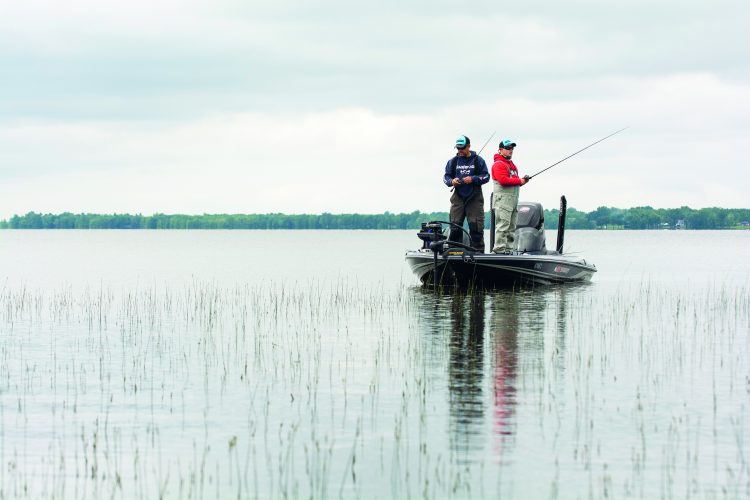
Water clarity has a big influence on the willingness of smallmouth and largemouth bass to bite a lure. It could be argued that, in general, fish in clear water are tougher customers. Granted, clearwater is only one variable in an equation that also includes light conditions, seasonal patterns, forage abundance and type, fish activity level, fishing pressure, and more. But, anglers who consider underwater visibility in their strategies and presentations get rewarded with more and bigger catches when clearwater bass fishing.
Over 80 percent of the waterbodies I fish are either naturally clear or have become so as a result of zebra and quagga mussels. What follows are some clearwater bass strategies I guarantee will help you put more fish in the boat this season.
(Note: On The Water is reader-supported. When you buy through links on our site, we may earn an affiliate commission.)
Technology: A Prologue
There are many ways to approach a discussion involving clearwater bass tactics, but the focus here is combining sonar and boat-control technologies with specific presentation strategies. As such, a quick overview on some important angling tech is in order.
Forward-scanning sonar is a huge advantage in clear water. Humminbird has its 360 Imaging, which gives an incredibly detailed view of water surrounding the boat up to 150 feet off all sides, like underwater radar. Then there’s Garmin’s innovative Panoptix. Its transducer can be pointed in various directions to achieve detailed, easy-to-interpret live-scanning sonar images of structure, bait and fish swimming below and around the boat in real time. Lowrance’s new LiveSight is another multi-directional, real-time, live sonar.
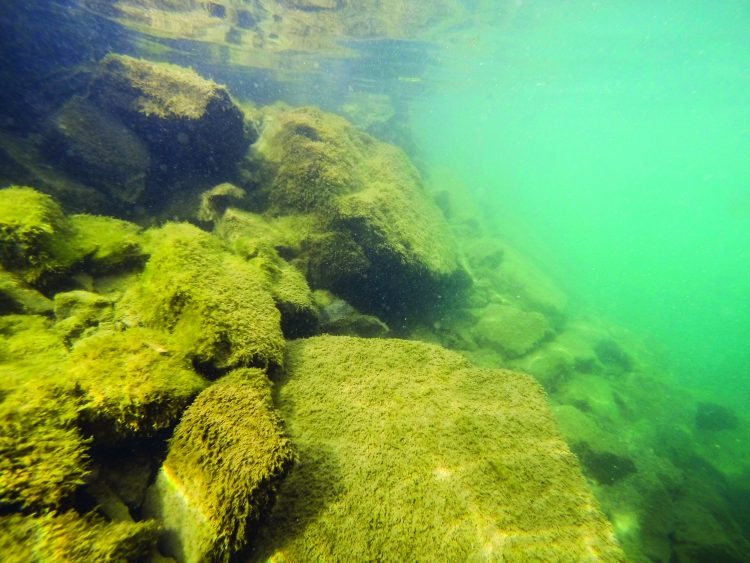
GPS waypoints, while nothing new, remain essential for marking key, fish-holding areas. Studying water with 2D and side-imaging sonar and amassing a stockpile of waypoints is the homework required for many of the clearwater strategies discussed below. These reference points help target precise areas, like a grass line or rock pile.
Part of this legwork can also include using an Aqua-Vu high-definition camera or other underwater viewing systems. These tools perform their best in clear water and do something sonar can’t: reveal fish species. I couldn’t tell you the number of times I’ve dropped a camera down on a hump or bar, expecting to see 5-pound smallmouth inhabiting the structure, and instead being surprised by channel catfish, walleye, or carp. Using a camera to ensure you’re on the right species instills confidence and prevents wasting time in the wrong areas.
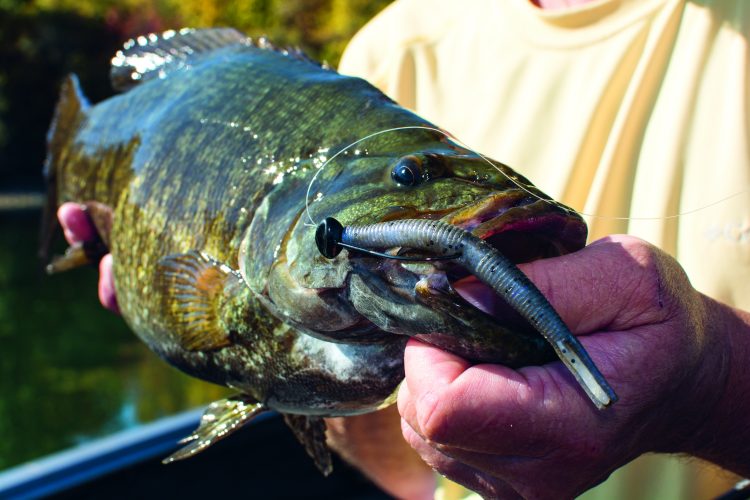
Strategy 1: Hover and stay back
If there’s a golden rule for bass fishing clear, open water, it may very well be, “Stay back and cast far.” A boat’s silhouette, combined with pinging sonars and other noise, puts bass on alert. Even when fishing from a barebones rig, angler movements and noise can spook fish. Drop a soda can, and it’s like the final curtain coming down, with bass quickly making an exit.
Adding a Minn Kota Terrova with Spot-Lock on my boat was a game changer for long-distance tactics. With a press of a button, the motor locks on the boat’s position, automatically adjusting thrust and direction to hold it in place. This allows my focus to shift to delivering the perfect presentation rather than positioning the boat.
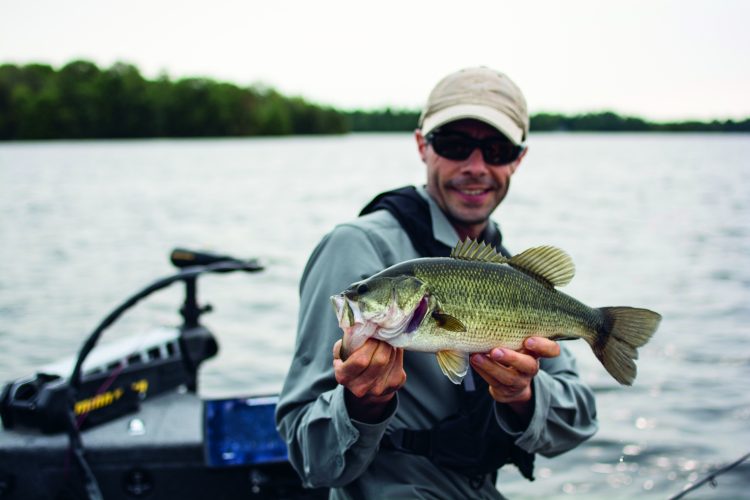
Spot-Lock really shines in the wind. When it’s breezy, boat control using either my Lund Pro Guide’s Mercury tiller or the foot-controlled electric motor requires constant vigilance and, frankly, gets tiring after a while. What I prefer in breezy weather is maneuvering the boat within casting range from prime structure and then engaging Spot-Lock. The trolling motor keeps the boat facing into the wind, and I fish from the roomy stern. This gives me the advantage of casting with the wind, which boosts distance. Plus, in rough water, it’s safer to be standing on the deck floor or sitting in the captain’s chair. After picking apart the spot, I stop Spot-Lock, keep the trolling motor in, gingerly reposition with the outboard, and repeat the process until the entire area is fished.
I often rely on this boat control system for basin-oriented, suspending smallmouth, which can really get riled up during windy conditions. These pelagic bass are up-feeders and are very aware of what’s over their heads, be it shad or boats. It’s not uncommon for them to suspend 10 to 20 feet down over depths of 30 to 50 feet. Staying back and making longs casts with a hard or soft-plastic jerkbait can be critical to catching these fish.
Like a lot of anglers, I have good success throwing 110-sized jerkbaits. However, in clear water, I’ve found downsizing to be quite effective. A 3-1/8-inch Rapala X-Rap is deadly for this approach; ditto for the 3-inch Megabass X-80 Trick Darter or 2-1/4-inch Lucky Craft Bevy Shad. In addition to jerkbaits, spinnerbait and chatterbaits are other good picks and really fly with the wind.
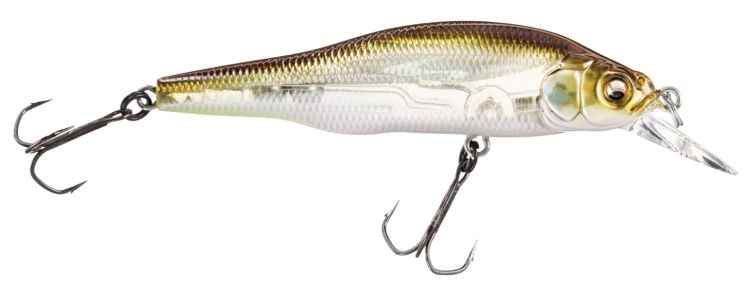

One thing you’ll know if you’ve fished smallmouth in this type of scenario is they quickly cover ground when active. When the bass are really moving, I’m more apt to fish from my bow and use the trolling motor to follow the school. I’ll Spot-Lock when needed, such as when playing a fish.
Long-distance tactics also work with bottom-contact presentations when bass are down-feeding on crayfish, sculpins, gobies and other forage. Many baits work here. Recently, I have done very well with the Z-Man Hula StickZ. Rig this buoyant, 4-inch finesse bait on a 1/8- to 1/4-ounce jighead and drag or hop it along bottom and down ledges. Other good picks include a 2.75- to 4-inch tube jig, finesse worm, beaver, or spider jig.
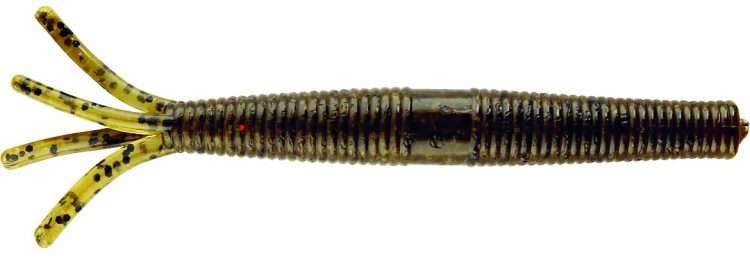
Then there’s the trend of using small swimbaits, like the 2.8-inch Jackall Rhythm Wave, Megabass Spark Shad, Storm 360GT Searchbait (and others) to work along the bottom. The method isn’t rocket science, but it takes patience to pull off as it requires slow, steady reeling to keep the bait swimming horizontally along the bottom or several feet above it. Speed up too much, and the swimbait rises like an ascending scuba diver and doesn’t look natural. Remember, we’re trying to fool bass in clear water. They’re going to scrutinize your lure like a reality TV show judging panel.
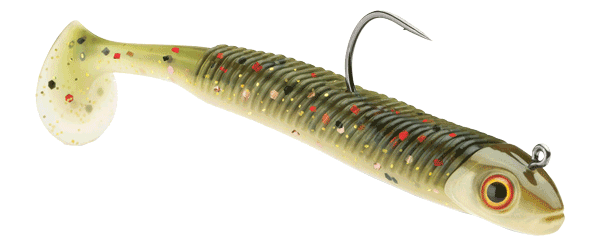

Using light braid is one trick that helps get a small finesse plastic or swimbait on a light jig to sink fast and move naturally. Great Lakes smallmouth specialist Derek Strub flings a tiny Rhythm Wave on 5-pound PowerPro braided line tied off to an 8-foot leader of 6- to 8-pound-test fluorocarbon. Anglers nervous about dropping this light can get by with 8- to 15-pound braid.
The next level of sophistication with long-distance casting involves bringing in the latest sonar technologies, like Humminbird’s 360, Garmin’s real-time Panoptix, and Lowrance’s LiveSight. Instead of targeting waypoints, anglers can target specific fish or structural elements revealed on the sonar.
Strategy 2: The long drift
Similar to distance-casting, drifting a bait on a long line keeps it away from the boat and fools clearwater bass. Here, the trolling motor is used to keep the boat on a specific course and pull baits over prime water. This may involve referencing waypoints or programming a specific route into a Minn Kota or Motorguide trolling motor. Minn Kota’s i-Pilot also allows anglers to use LakeMaster or AutoChart Live data to follow depth contour. Precision never hurts when chasing bass.
Many presentations work for a drifting approach – a drop-shot rig is one, but there are a couple of factors anglers need to consider when drifting it. For example, because it’s being pulled on an angle, the bait will run closer to bottom than when fished vertically. For example, a 16-inch tag may position the bait closer to 8 inches off bottom when drifting. This is an important detail when bass have a small strike window.

Another consideration is bait style and size. Drifting (and casting) a drop-shot is different than vertically fishing it. I shake a bait more when fishing it straight down. When drifting, I let the weight’s bumping, stalling and hopping along bottom do the work of dancing the bait. Drifting a drop-shot is more of a swim than a shake, so to speak, and I speculate it’s why I do better with 4- to 4-1/2-inch thin worms that have an alluring, undulating action over shorter, stubbier plastics.
A thin swimbait is another lure to try, and it puts out plenty of action thanks to its paddletail. Bassmaster Elite Pro Chris Johnston is a fan of nose-hooking a 2.8-inch Jackall Rhythm Wave on a size 1 drop-shot hook. This is tied to an 8-pound fluorocarbon leader and then to 10-pound PowerPro braid. He uses as light a weight as possible to maintain bottom contact.
Johnston drags and drifts this rig. Speaking to an event on the St. Lawrence River, he noted getting the bait a cast-length away from the boat was key. “We got way more bites doing that this year than your standard drop-shot bait rig below the boat,” he said.

Drifting isn’t just for drop-shot rigs, however. Dragging a 3- to 4-inch tube, swimbait, or creature bait on a football jighead will catch bass on mid- to deep flats and ledges. Use the rod to pull the bait forward, then drop the rod back to stall the presentation on bottom as the boat continues moving forward. Using an articulated football head, like a VMC Swingin’ Rugby Head or Freedom Tackle Jig, will add more lifelike action to a plastic. In clear water, this more fluid movement can equate to increased bites. Dragging a 4- to 6-inch Texas-rigged worm with a bullet weight or salt-loaded stickbait is also deadly.
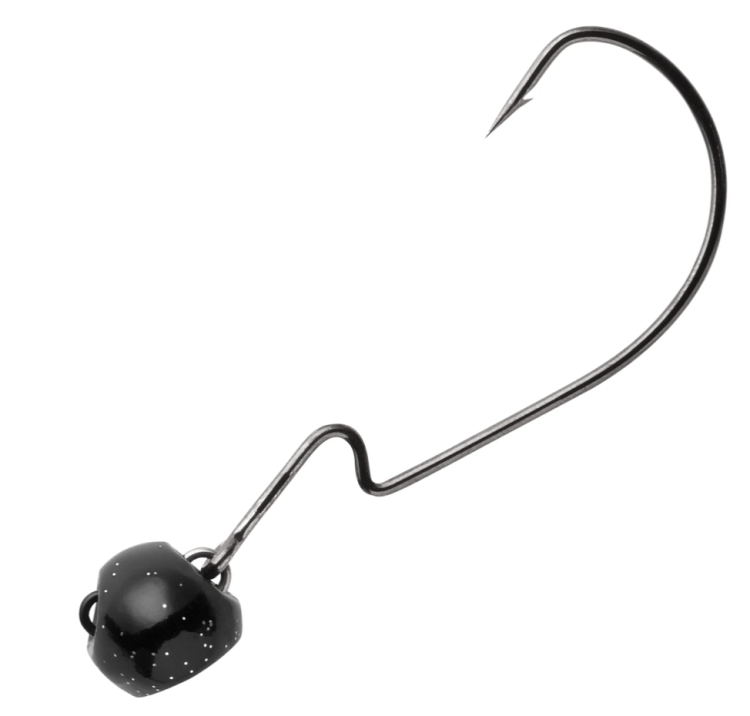
It isn’t all about bottom-contact tactics, though. From skinny to deep water, I have seen a 4- to 5-inch fluke put big bass in the boat over the years. Rigged Tex-posed on an EWG hook, a jerk shad is a great choice for anglers fishing from the stern. Bomb this bait out and give it the odd twitch while the angler up front moves the boat along with the trolling motor. This dying baitfish presentation is phenomenal on overcast days, but it also surprises me how well it fishes in bright sun.
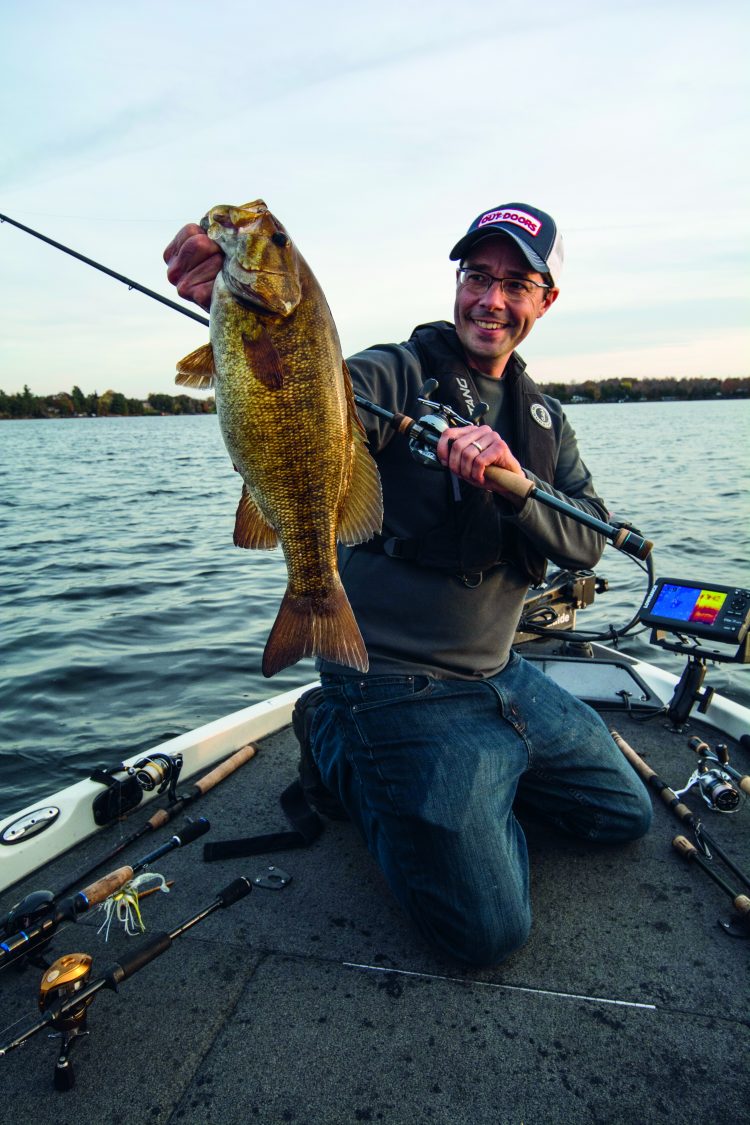
Strategy 3: Drop spikes and strategize
Shallow-water anchors are another game-changing piece of technology for the clearwater angler. A Power-Pole Blade locks a boat in place up to 10 feet, while 15 feet is the longest model available in the Minn Kota Talon series.
Whether targeting largemouth or smallmouth in 15 feet or less, being able to quietly deploy an anchor (or two) and lock the boat in place eliminates electric trolling motor noise. On pressured water, bass get savvy to prop noise and can shut down or get very choosy about what they eat.
Anchoring also dramatically limits boat movement. Two spikes are better than one for reducing boat sway, but one pole will still prevent a boat from drifting over a school of fish. Without question, having a Talon to hold my boat in place and not drifting with current, helps me catch more shallow-water smallmouth from the gin-clear, fast-flowing St. Lawrence River. Same on breezy days on my favorite lakes.
Like using Spot-Lock in deep water, shallow anchors maintain boat position, letting an angler concentrate on executing the perfect presentation. Daiwa pro Dave Chong loves his Power-Pole Blades for this reason – they help him lock his Skeeter in place and be more calculated and precise with boat position, which in turn means better presentations.
“There usually is an ideal angle to approach a dock, tree, stump, weed line, or other fishing situation,” Chong said. “Power-Poles give me the confidence to be patient and get the boat in the right position, anchor it in place, then make the right cast.”
When working grass, getting a bait along an edge or into an opening is especially important in bright conditions when bass are tight to cover. Being locked in place provides extra time to lift and drop a jig, shake a Neko rig or tube jig, or dance a frog side to side over an opening in a mat. Even more, when anchored an angler can take as much time as needed to work the area thoroughly. The poles can then be raised, the boat moved to the next stretch, and anchors deployed again.

Having time to strategize and deliver a perfect presentation is just as critical in open, shallow areas like flats. Big smallmouth love to cruise and forage on skinny water sand flats and so will largemouth in low-light or other conditions that give them a hunting advantage. Rock piles, grass patches, pencil reeds, and timber boost an area’s appeal, but generally there’s not a lot of cover on flats.
Making long casts is a reliable approach. One of the deadliest lures I’ve used for the distance game is a Duo Realis Spinbait 80. The Jackall iProp and Storm Arashi Spinbait are other examples.
In clear water, a spybait is like a skeleton key for lock-jawed bass. It requires an ultra-slow retrieve and, as such, one can’t cover water like a reaction bait. To be as effective as possible, it’s important to choose casting angles that bring the bait where big fish are going to set up. This was a tip I got years ago from David Swendseid, an Oregon-based research and development specialist for Japanese companies, who was giving me a crash course in spybaiting. It resonated with me due to my muskie-fishing experience and certainly helped me hone using a spinbait. Casting-angle targets may include along a flats ledge, over a rock pile, through a trough cutting across shallow water, along a current seam, and so on. Locking the boat in place with shallow-water anchors helps execute this presentation more effectively.

Sight-fishing for bass using short to medium casts also has merit and is a strategy my kids and I regularly use with Ned rigs and other finesse presentations. One of the biggest factors for getting bites is sink rate, so we use 1/20- and 1/15-ounce jigs whenever we can get away with it.
While fishing with the family is often a numbers game, when out with buddies on shallow flats, we focus more on quality over quantity. It’s a different game. Getting bites takes time, and if you can see the bass, they can see you.
Finessing these fish is much easier to do from a stable platform compared to a moving boat with an operating trolling motor, which can spook fish. Plus, I think bass let their guard down after a while if you’re stealthy enough.

Another reason it pays to park on a spot is that sometimes the best way to catch big bass is to do nothing at all and deadstick a bait. My go-tos include 2.5- to 3.5-inch tube jigs, Z-Man’s 4-inch Hula StickZ and 2.75-inch TRD, 3-inch craws and creature baits, small bucktail jigs, and finesse worms on drop-shot rigs. In all cases, the strategy involves seeing where bass are mingling on a flat and then casting the bait to that area. Aim past the pack to avoid spooking them. Let the lure sink to bottom on slack line, then do absolutely nothing. I used to wait a couple minutes, then Chong told me he might soak a tube or drop-shot rig for up to 10 minutes to get a bass to bite. This is often his follow-up strategy after a hot bass has followed a bait to the boat, then turned and swam off.
After soaking a bait for a while where you’ve seen a bass or pod of them milling about, try adding a small shake or hop to move the bait slightly and pique their curiosity. Add a few more and work the bait back to the boat.

When sight-fishing for bass, don’t assume failure if you are unsuccessful on the first few casts. Experiment, and keep trying other baits. It can take a while to crack the code on what presentation, profile, and color the bass want. It’s also a great idea to douse baits with a fish attractant like Liquid Mayhem. If you just can’t get any action, come back later and try longer casts as outlined in the first strategy.
Leveraging the latest sonar and boat-control technology to locate fish and avoid spooking them will serve anglers well and help execute flawless presentations. This is often what’s needed to get choosy, clearwater bass to bite.
Related Content
Article: Two Rigs You Need for Cold Water Largemouth
Leave a Reply